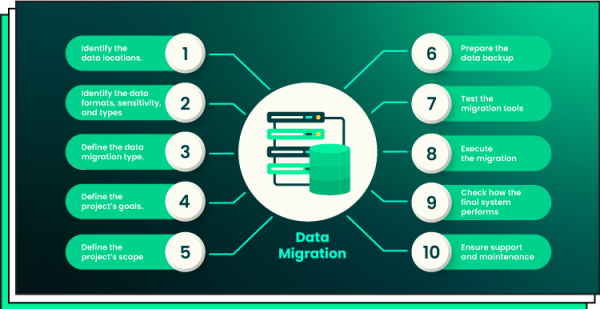Data migration is essential for businesses upgrading their IT infrastructure, optimizing processes, or transitioning to cloud solutions. This article explores effective data migration methods and presents case studies highlighting successful migrations facilitated by Visual Flow’s cutting-edge technology.

Key Methods for Efficient Data Migration
Planning and Assessment
- Define Objectives: Outline the goals of the migration, such as performance improvements, cost reductions, or compliance enhancements.
- Inventory and Analysis: Conduct a thorough inventory of existing data and systems to assess compatibility, quality, and dependencies.
Data Mapping and Transformation
- Map Data Elements: Establish detailed mappings of source data to target systems to ensure all necessary fields are accounted for.
- Transform Data: Use Visual Flow’s ETL/ELT tools to convert data into a compatible format, addressing any inconsistencies or errors seamlessly.
Utilizing the Right Tools
- Low-Code Solutions: Visual Flow offers a low-code, open-source ETL/ELT solution with a drag-and-drop interface, allowing even non-technical users to set up data pipelines effortlessly.
- Scalability Tools: Leveraging Apache Spark and Kubernetes, Visual Flow ensures scalability and parallel processing capabilities for large datasets.
Testing and Validation
- Pilot Testing: Perform initial tests on a small dataset to validate the migration strategy and tools.
- Full-scale Testing: Conduct comprehensive testing to ensure data integrity, performance, and security requirements are met.
Execution and Monitoring
- Phased Approach: Execute migration in phases to manage risks and allow for adjustments based on continuous monitoring and feedback.
- Real-time Monitoring: Utilize Visual Flow’s real-time monitoring features to address issues promptly and minimize downtime.
Post-Migration Activities
- Validation and Cleanup: Validate the migrated data to ensure accuracy and completeness. Clean up any residual data from the old system.
- Training and Support: Provide adequate training and support to users to facilitate a smooth transition to the new system.
Case Studies: Lessons from Real-World Migrations
Case Study 1: Cost Reduction and Performance Boost
A major IT company leveraged Visual Flow to cut ETL costs by 5x and boost performance by 3x. The use of open-source technologies and scalable infrastructure enabled significant reductions in operational costs while enhancing processing speeds.
Case Study 2: Rapid Deployment and Scalability
Another client utilized Visual Flow’s low-code solution to set up data pipelines within 15 minutes, achieving rapid deployment without writing a single line of code. The integration of Kubernetes and Apache Spark ensured the scalability necessary to handle growing data volumes.
Case Study 3: Flexibility and Customization
A business facing complex data integration challenges benefited from Visual Flow’s customization options. The ability to tailor ETL processes to specific needs, combined with no vendor lock-in, provided unparalleled flexibility and cost-effective solutions.
Conclusion
Effective data migration requires meticulous planning, the right tools, and rigorous testing. Visual Flow’s innovative solutions empower businesses to navigate these complexities with ease, ensuring seamless transitions and optimized outcomes. By learning from real-world examples, companies can adopt best practices and leverage powerful ETL/ELT tools for successful data migrations.
For more information on how Visual Flow can assist with your data migration needs, visit Visual Flow.


